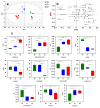1H-NMR Metabolomics as a Tool for Winemaking Monitoring
- PMID: 34833863
- PMCID: PMC8621607
- DOI: 10.3390/molecules26226771
1H-NMR Metabolomics as a Tool for Winemaking Monitoring
Abstract
The chemical composition of wine is known to be influenced by multiple factors including some viticulture practices and winemaking processes. 1H-NMR metabolomics has been successfully applied to the study of wine authenticity. In the present study, 1H-NMR metabolomics in combination with multivariate analysis was applied to investigate the effects of grape maturity and enzyme and fining treatments on Cabernet Sauvignon wines. A total of forty wine metabolites were quantified. Three different stages of maturity were studied (under-maturity, maturity and over-maturity). Enzyme treatments were carried out using two pectolytic enzymes (E1 and E2). Finally, two proteinaceous fining treatments were compared (vegetable protein, fining F1; pea protein and PVPP, fining F2). The results show a clear difference between the three stages of maturity, with an impact on different classes of metabolites including amino acids, organic acids, sugars, phenolic compounds, alcohols and esters. A clear separation between enzymes E1 and E2 was observed. Both fining agents had a significant effect on metabolite concentrations. The results demonstrate that 1H-NMR metabolomics provides a fast and robust approach to study the effect of winemaking processes on wine metabolites. These results support the interest to pursue the development of 1H-NMR metabolomics to investigate the effects of winemaking on wine quality.
Keywords: 1H-NMR; metabolomics; wine; winemaking.
Conflict of interest statement
The authors declare no conflict of interest.
Figures




Similar articles
-
Influence of Grape Composition on Red Wine Ester Profile: Comparison between Cabernet Sauvignon and Shiraz Cultivars from Australian Warm Climate.J Agric Food Chem. 2015 May 13;63(18):4664-72. doi: 10.1021/acs.jafc.5b00966. Epub 2015 May 4. J Agric Food Chem. 2015. PMID: 25905977
-
Co-winemaking with Vitis amurensis Rupr. "Beibinghong" enhances the quality of Vitis vinifera L. cv. Cabernet Gernischt wine.J Food Sci. 2022 Nov;87(11):4854-4867. doi: 10.1111/1750-3841.16330. Epub 2022 Sep 27. J Food Sci. 2022. PMID: 36165679
-
Potato Protein Fining of Phenolic Compounds in Red Wine: A Study of the Kinetics and the Impact of Wine Matrix Components and Physical Factors.Molecules. 2019 Dec 13;24(24):4578. doi: 10.3390/molecules24244578. Molecules. 2019. PMID: 31847298 Free PMC article.
-
Wine and grape marc spirits metabolomics.Metabolomics. 2018 Dec 11;14(12):159. doi: 10.1007/s11306-018-1458-1. Metabolomics. 2018. PMID: 30830493 Review.
-
Wine Fining with Plant Proteins.Molecules. 2019 Jun 11;24(11):2186. doi: 10.3390/molecules24112186. Molecules. 2019. PMID: 31212597 Free PMC article. Review.
Cited by
-
Compositional Analysis of Four Kinds of Citrus Fruits with an NMR-Based Method for Understanding Nutritional Value and Rational Utilization: From Pericarp to Juice.Molecules. 2022 Apr 16;27(8):2579. doi: 10.3390/molecules27082579. Molecules. 2022. PMID: 35458777 Free PMC article.
-
The Metabolic and Antioxidant Activity Profiles of Aged Greek Grape Marc Spirits.Foods. 2024 May 26;13(11):1664. doi: 10.3390/foods13111664. Foods. 2024. PMID: 38890893 Free PMC article.
-
Automatic Chemical Profiling of Wine by Proton Nuclear Magnetic Resonance Spectroscopy.ACS Food Sci Technol. 2024 Jul 22;4(8):1937-1949. doi: 10.1021/acsfoodscitech.4c00298. eCollection 2024 Aug 16. ACS Food Sci Technol. 2024. PMID: 39170760 Free PMC article.
-
NMR Metabolite Profiling for the Characterization of Vessalico Garlic Ecotype and Bioactivity against Xanthomonas campestris pv. campestris.Plants (Basel). 2024 Apr 23;13(9):1170. doi: 10.3390/plants13091170. Plants (Basel). 2024. PMID: 38732385 Free PMC article.
-
Advances in Natural Product Extraction Techniques, Electrospun Fiber Fabrication, and the Integration of Experimental Design: A Comprehensive Review.Molecules. 2023 Jul 2;28(13):5163. doi: 10.3390/molecules28135163. Molecules. 2023. PMID: 37446825 Free PMC article. Review.
References
-
- Cevallos-Cevallos J.M., Reyes-De-Corcuera J.I., Etxeberria E., Danyluk M.D., Rodrick G.E. Metabolomic analysis in food science: A review. Trends Food Sci. Technol. 2009;20:557–566. doi: 10.1016/j.tifs.2009.07.002. - DOI
-
- Valls Fonayet J., Loupit G., Richard T. Chapter Ten—MS- and NMR-metabolomic tools for the discrimination of wines: Applications for authenticity. Adv. Bot. Res. 2021;98:297–357.
MeSH terms
Grants and funding
LinkOut - more resources
Full Text Sources
Miscellaneous

